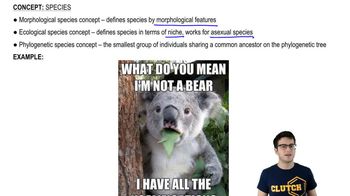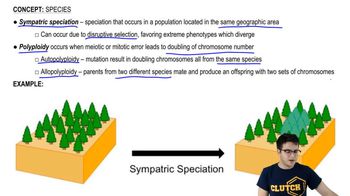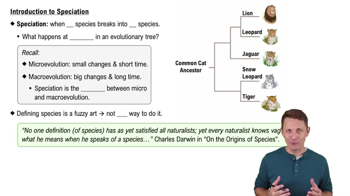NARRATOR: All Darwin's finches, like fortis and scandens, are similar in plumage. All build their domed nests hidden in cactus. All have similar courtship behavior, often using a white seabird feather. They differ in body size, beak size and shape, and in song. It is song, in association with the bird's appearance, body size, and beak dimensions, that is a pre-mating barrier to interbreeding between the species. [FINCH CALLS] Fortis has a blunt beak, scandens a sharp pointed beak, magnirostris a massive beak. [FINCH CALLS] Fortis songs, on the left, are short and modulated. Scandens songs, on the right, are a series of repeated notes. All individuals sing one short song. There is variation between individuals, but always on a species-specific song theme. The fortis song above sounds like this. [FINCH CALL] A more rapid variation from another fortis individual sounds like this. [FINCH CALL] Scanden song, with repeated notes, like this. [FINCH CALL] The scandens, below, has a compressed song like this. [FINCH CALL] It is not difficult for us to tell the species apart using size, beak shape, and song. But can the birds? To test if a male territory owner can discriminate between its own and another species by appearance alone, we put two stuffed museum specimens, a female fortis and a female scandens, at either end of a pole. The answer was a clear yes, as demonstrated in this old Super 8 video, taken on Genovesa with two different species of ground finches. The female of the male's own species is on the right. The female of the other species on the left. The male territory owner flies up, moves left, and then towards the female of his own species, courts briefly, and attempts to mount. He flies down, picks up a white seabird feather, courts again, and mounts. We then asked if an individual could distinguish between its own and another species purely on the basis of song, in the absence of any morphological cues? Again, the answer was yes. Playback of previously recorded scandens song elicited a response from scandens, but not from fortis. Likewise, fortis responded to fortis song, but not scandens song.
Table of contents
- 1. Introduction to Biology2h 40m
- 2. Chemistry3h 40m
- 3. Water1h 26m
- 4. Biomolecules2h 23m
- 5. Cell Components2h 26m
- 6. The Membrane2h 31m
- 7. Energy and Metabolism2h 0m
- 8. Respiration2h 40m
- 9. Photosynthesis2h 49m
- 10. Cell Signaling59m
- 11. Cell Division2h 47m
- 12. Meiosis2h 0m
- 13. Mendelian Genetics4h 41m
- Introduction to Mendel's Experiments7m
- Genotype vs. Phenotype17m
- Punnett Squares13m
- Mendel's Experiments26m
- Mendel's Laws18m
- Monohybrid Crosses16m
- Test Crosses14m
- Dihybrid Crosses20m
- Punnett Square Probability26m
- Incomplete Dominance vs. Codominance20m
- Epistasis7m
- Non-Mendelian Genetics12m
- Pedigrees6m
- Autosomal Inheritance21m
- Sex-Linked Inheritance43m
- X-Inactivation9m
- 14. DNA Synthesis2h 27m
- 15. Gene Expression3h 20m
- 16. Regulation of Expression3h 31m
- Introduction to Regulation of Gene Expression13m
- Prokaryotic Gene Regulation via Operons27m
- The Lac Operon21m
- Glucose's Impact on Lac Operon25m
- The Trp Operon20m
- Review of the Lac Operon & Trp Operon11m
- Introduction to Eukaryotic Gene Regulation9m
- Eukaryotic Chromatin Modifications16m
- Eukaryotic Transcriptional Control22m
- Eukaryotic Post-Transcriptional Regulation28m
- Eukaryotic Post-Translational Regulation13m
- 17. Viruses37m
- 18. Biotechnology2h 58m
- 19. Genomics17m
- 20. Development1h 5m
- 21. Evolution3h 1m
- 22. Evolution of Populations3h 52m
- 23. Speciation1h 37m
- 24. History of Life on Earth2h 6m
- 25. Phylogeny2h 31m
- 26. Prokaryotes4h 59m
- 27. Protists1h 12m
- 28. Plants1h 22m
- 29. Fungi36m
- 30. Overview of Animals34m
- 31. Invertebrates1h 2m
- 32. Vertebrates50m
- 33. Plant Anatomy1h 3m
- 34. Vascular Plant Transport2m
- 35. Soil37m
- 36. Plant Reproduction47m
- 37. Plant Sensation and Response1h 9m
- 38. Animal Form and Function1h 19m
- 39. Digestive System10m
- 40. Circulatory System1h 57m
- 41. Immune System1h 12m
- 42. Osmoregulation and Excretion50m
- 43. Endocrine System4m
- 44. Animal Reproduction2m
- 45. Nervous System55m
- 46. Sensory Systems46m
- 47. Muscle Systems23m
- 48. Ecology3h 11m
- Introduction to Ecology20m
- Biogeography14m
- Earth's Climate Patterns50m
- Introduction to Terrestrial Biomes10m
- Terrestrial Biomes: Near Equator13m
- Terrestrial Biomes: Temperate Regions10m
- Terrestrial Biomes: Northern Regions15m
- Introduction to Aquatic Biomes27m
- Freshwater Aquatic Biomes14m
- Marine Aquatic Biomes13m
- 49. Animal Behavior28m
- 50. Population Ecology3h 41m
- Introduction to Population Ecology28m
- Population Sampling Methods23m
- Life History12m
- Population Demography17m
- Factors Limiting Population Growth14m
- Introduction to Population Growth Models22m
- Linear Population Growth6m
- Exponential Population Growth29m
- Logistic Population Growth32m
- r/K Selection10m
- The Human Population22m
- 51. Community Ecology2h 46m
- Introduction to Community Ecology2m
- Introduction to Community Interactions9m
- Community Interactions: Competition (-/-)38m
- Community Interactions: Exploitation (+/-)23m
- Community Interactions: Mutualism (+/+) & Commensalism (+/0)9m
- Community Structure35m
- Community Dynamics26m
- Geographic Impact on Communities21m
- 52. Ecosystems2h 36m
- 53. Conservation Biology24m
23. Speciation
Introduction to Speciation
Video duration:
3mPlay a video:
Related Videos
Related Practice

















